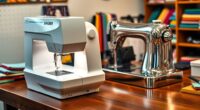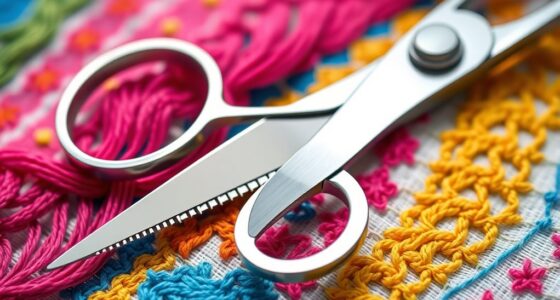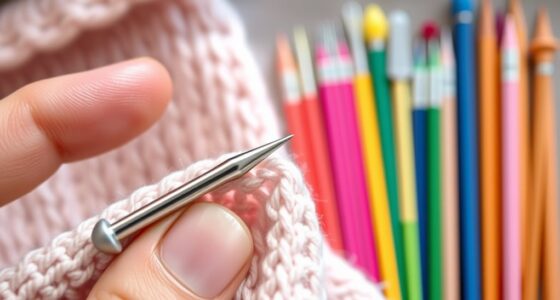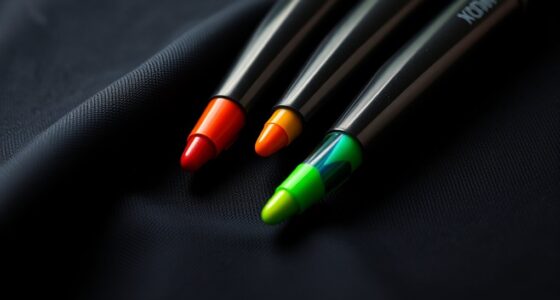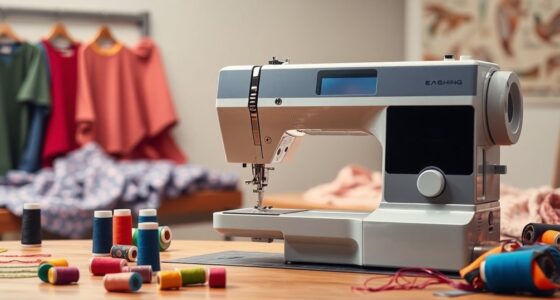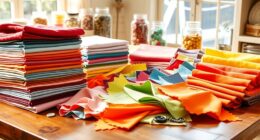When I'm working on upholstery projects, I know how essential it is to have the right sewing machine. From the SINGER Heavy Duty 4452 to the Juki DDL-8700-H, these models are reliable for heavy fabrics. I also appreciate the user-friendly Brother XM2701 for light projects, and the robust Xuthusman Industrial Machine for speed. Each option brings unique features to the table, helping achieve professional results. Stick around to find out more about the best picks and key considerations!
Key Takeaways
- Choose machines with strong motors, like the SINGER Heavy Duty models, to handle thick upholstery fabric effectively.
- Look for high-speed sewing capabilities, such as the Juki DDL-8700-H, to enhance productivity on large projects.
- Select machines with automatic lubrication systems, which help maintain performance and reduce downtime during upholstery work.
- Consider models with a walking foot feature, like the Consew Walking Foot Industrial Machine, for better fabric feeding on multiple layers.
- Ensure the machine has a robust metal frame for stability, especially during high-speed sewing tasks on heavy materials.
SINGER Heavy Duty 4452 High Speed Sewing Machine
If you're looking for a sewing machine that can handle upholstery projects with ease, the SINGER Heavy Duty 4452 is a fantastic choice. I love its strong motor, which easily pierces through multiple layers of thick fabrics like denim. With 110 stitch applications and a simple Stitch Selector Dial, I can quickly switch between styles. The built-in needle threader saves me time, while the top drop-in bobbin lets me monitor thread supply effortlessly. Plus, its mechanical design makes maintenance a breeze. Overall, it's user-friendly and perfect for anyone seeking reliable heavy-duty capabilities without complicated features.
Best For: Individuals seeking a reliable sewing machine capable of handling heavy-duty projects like upholstery and denim.
Pros:
- Strong motor allows for easy sewing through multiple layers of thick fabrics.
- User-friendly design with easy stitch selection and built-in needle threader.
- Comprehensive accessory kit and extension table enhance versatility for various projects.
Cons:
- Some users report thread jamming issues with the upright spool pin.
- The machine may be noisier than other models.
- Not designed for dual voltage, which might be a concern for international buyers.
Juki DDL-8700-H Industrial Straight Stitch Sewing Machine
The Juki DDL-8700-H Industrial Straight Stitch Sewing Machine stands out as an ideal choice for serious upholstery enthusiasts and professionals alike, thanks to its impressive max sewing speed of 4,000 RPM. This high-speed lock-stitch machine handles heavy materials with ease, making it perfect for outdoor gear and bags. I appreciate its automatic lubrication system, which keeps everything running smoothly. Assembly is required, but I found online resources helpful. While it's important to have extra needles on hand, the included accessories cover most needs. Overall, this machine's performance and durability make it a solid investment for any upholstery project.
Best For: The Juki DDL-8700-H Industrial Straight Stitch Sewing Machine is best for upholstery enthusiasts and professionals who work with heavy materials and need high-speed performance.
Pros:
- Excellent for sewing heavy fabrics and capable of handling thick materials.
- Quiet operation with an automatic lubrication system for smooth performance.
- Comprehensive accessories included, providing essential tools for various projects.
Cons:
- Assembly instructions can be complicated and may lead to missing components.
- Some users report uneven stitching and complicated operation without a manual.
- Customer service issues reported regarding damaged items and refund processes.
Xuthusman Industrial Leather and Upholstery Sewing Machine
Designed for heavy-duty tasks, the Xuthusman Industrial Leather and Upholstery Sewing Machine is perfect for professionals like tailors and fashion designers. With a powerful 550W motor and a maximum speed of 6500rpm, it makes quick work of any project. I love that it achieves up to 3500 stitches per minute, effortlessly handling materials up to 0.2 inches thick. Plus, the adjustable stitch length caters to all my sewing needs. Operating quietly at just 30dB, it's a great fit for any workspace. Just remember to lubricate it with #10 white oil for peak performance!
Best For: Tailors, fashion designers, and professionals in heavy-duty sewing requiring high-speed and durable performance.
Pros:
- High sewing speed of up to 3500 stitches per minute for efficient production.
- Quiet operation at just 30dB, making it suitable for any workspace.
- Adjustable stitch length allows for versatility in various sewing projects.
Cons:
- Requires regular lubrication with #10 white oil to prevent mechanical issues.
- Not pre-installed, necessitating careful setup which may be challenging for some users.
- Mixed customer ratings (2.7 out of 5 stars) indicating potential reliability concerns.
Brother XM2701 Sewing Machine (Lightweight, 27 Stitches)
For anyone venturing into the world of upholstery work, the Brother XM2701 sewing machine is a fantastic choice thanks to its lightweight design and 27 built-in stitches. I found the automatic needle threader and jam-resistant drop-in bobbin made setup a breeze. It's perfect for beginners, as I easily tackled projects like hemming pants with its clear instructions. While it handles light to medium fabrics well, I noticed it struggles with thicker materials. The support from Brother is excellent, too, with free technical assistance available. Overall, it's a reliable machine that's great for honing your sewing skills without feeling overwhelmed.
Best For: Beginners looking to learn sewing skills and tackle everyday projects without intimidation.
Pros:
- Easy setup and operation with clear instructions, making it suitable for novice sewers.
- Versatile with 27 built-in stitches, allowing for various sewing tasks from decorative to practical.
- Excellent customer support with free technical assistance available for the machine's lifetime.
Cons:
- Struggles with thicker fabrics, such as denim, limiting its use for heavier upholstery projects.
- Lightweight design may lead to instability when sewing at high speeds or with heavier materials.
- Limited advanced features, which may not satisfy experienced sewists looking for more complex capabilities.
Juki DDL-8700 Lockstitch Sewing Machine Combo
With a max sewing speed of 5,500 stitches per minute, the Juki DDL-8700 Lockstitch Sewing Machine Combo is perfect for both beginners and experienced upholsterers looking to enhance their sewing efficiency. This high-speed machine handles light to medium weight materials effortlessly, thanks to its durable electronic motor. I appreciate the included thread stand, extra needles, and oil pan, which make setup much easier. However, I did encounter some assembly challenges, so I recommend checking online resources for help. Overall, this machine's performance and quality make it a solid choice for serious sewing projects.
Best For: The Juki DDL-8700 Lockstitch Sewing Machine is best for both beginners and experienced sewers who require a high-speed machine for light to medium weight materials.
Pros:
- High sewing speed of 5,500 stitches per minute enhances sewing efficiency.
- Durable electronic motor provides consistent performance for various sewing projects.
- Includes essential accessories like extra needles and a thread stand, simplifying setup.
Cons:
- Assembly instructions may be unclear, leading to potential challenges during setup.
- Some users reported missing parts or issues with packaging during shipping.
- Not a walking foot machine, which may limit its use for certain heavy materials.
SINGER Heavy Duty 500 Classic Sewing Machine
The SINGER Heavy Duty 500 Classic Sewing Machine stands out as an exceptional choice for anyone tackling upholstery projects, thanks to its powerful motor that delivers 50% more strength than standard machines. I love its vintage-inspired design, which adds charm to my sewing space while providing essential features like a built-in needle threader and one-step buttonhole. The robust metal frame guarantees stability during high-speed sewing, making it easy to work with heavy fabrics. Plus, the customizable stitch settings allow for precision in every project. With a thorough accessory kit, I find it user-friendly and perfect for my upholstery endeavors.
Best For: The SINGER Heavy Duty 500 Classic Sewing Machine is best for sewing enthusiasts who work with heavy fabrics and appreciate a blend of vintage design and modern functionality.
Pros:
- Powerful motor providing 50% more strength than standard machines, ideal for heavy fabrics like denim and canvas.
- Customizable stitch settings allow for flexibility and precision in various sewing techniques.
- Robust metal frame ensures stability and durability during high-speed sewing projects.
Cons:
- Some users report difficulties with threading, which may require practice.
- The manual availability can be limited, potentially causing confusion for new users.
- While user-friendly, initial setup may take some time to master for beginners.
Portable Sewing Machine for Beginners with Sewing Table
Looking for a beginner-friendly sewing machine that's perfect for both kids and adults? I found an incredible portable sewing machine that comes with a sewing table, making it easy to set up anywhere. It features 12 built-in stitches and a foot pedal for simple operation. The extensive 40-piece kit includes everything from scissors to a tape measure, ensuring you're ready to sew right away. Plus, the threading guide printed on the machine is super helpful! Lightweight and versatile, it's an ideal gift for any occasion, and it operates on AC power or batteries. You'll love this handy tool!
Best For: Beginners, children ages 8-12, and sewing enthusiasts looking for a portable and user-friendly sewing machine.
Pros:
- Lightweight and portable design, making it easy to transport.
- Includes a comprehensive 40-piece sewing kit to get started immediately.
- User-friendly features like a threading guide and clear instructions for easy operation.
Cons:
- Limited to 12 built-in stitches, which may not be enough for advanced projects.
- Operates on batteries that need to be purchased separately for portability.
- Smaller size may not accommodate larger sewing projects comfortably.
Consew Walking Foot Industrial Sewing Machine with Table and Servo Motor
For anyone tackling a variety of upholstery projects, the Consew Walking Foot Industrial Sewing Machine with Table and Servo Motor stands out as a top-tier choice. It's perfect for everything from furniture to marine applications, handling light to heavy-weight materials with ease. After a bit of break-in and fine-tuning, I found its performance impressive, rivaling other well-known models. However, be prepared for assembly challenges and possible customer service hiccups—some users reported missing parts and alignment issues. If you're willing to navigate those bumps, this machine can be a fantastic addition to your sewing toolkit.
Best For: Upholstery enthusiasts and professionals who work with a variety of materials, including leather and canvas, and need a reliable industrial sewing machine. These users require machines that offer durability, precision, and versatility to handle heavy-duty fabrics without compromising on performance. With robust stitching capabilities and a range of features tailored for specific upholstery tasks, they can efficiently complete projects with ease. Whether sewing intricate patterns or reinforcing seams, these are truly the best sewing machines for upholstery, ensuring that both amateurs and pros can achieve professional results every time.
Pros:
- Excellent performance on light to heavy-weight materials, making it versatile for different upholstery projects.
- Smooth operation after the break-in period, comparable to other high-end models like the 206rb-5.
- Robust design with features such as an oil pump system for consistent lubrication.
Cons:
- Assembly can be challenging due to the lack of instructions, and some users reported broken components upon delivery.
- Customer service issues reported, particularly regarding missing parts and warranty claims.
- Potential for initial setup difficulties, including alignment issues with the thread tensioner.
Xuthusman Electric Sewing Machine for Leather and Canvas
Crafted specifically for heavy-duty tasks, the Xuthusman Electric Sewing Machine excels in handling leather and canvas with ease. With a powerful 190W motor, it reaches an impressive speed of 1,800 stitches per minute, making my projects quicker and more efficient. I love the versatility of its two modes for manual and automatic wire cutting. Weighing just 2.9kg, it's easy to maneuver. Plus, the insulated handle guarantees comfort during long sessions. Whether I'm sealing bags or working on upholstery, this machine's robust construction assures durability and precision. It's become an essential tool in my sewing arsenal.
Best For: Professionals and hobbyists in the sewing industry looking for a reliable machine to work with heavy materials like leather and canvas.
Pros:
- High efficiency with a maximum speed of 1,800 stitches per minute, reducing project time.
- Versatile functionality with both manual and automatic wire cutting modes for ease of use.
- Durable construction featuring a pure copper motor and metal synchronous wheel, ensuring long-lasting performance.
Cons:
- Limited maximum thickness of 6mm may not accommodate very thick materials without adjustments.
- Weight of 2.9kg may be cumbersome for some users during transport or repositioning.
- Specialized use primarily for leather and canvas, which may limit its applications compared to more general sewing machines.
Handheld Portable Mini Sewing Machine for Beginners
If you're a beginner exploring the world of sewing, the handheld portable mini sewing machine is an excellent choice. It's compact, lightweight, and perfect for quick projects. With its unique curved design, I found it easy to operate with just one hand. The two-speed option made it efficient for various tasks, from simple repairs to DIY creations. Plus, the colorful instruction manual guided me through the threading process seamlessly. It even comes with essential accessories like scissors and thread. While it might struggle with thicker fabrics, it's ideal for casual use and has received great reviews from fellow beginners.
Best For: Beginners looking for a portable and user-friendly sewing machine for quick projects and basic repairs.
Pros:
- User-friendly design with a colorful instruction manual for easy setup and operation.
- Compact and lightweight, making it ideal for on-the-go sewing and storage.
- Two-speed option allows for efficient sewing on various fabric types, including thicker materials.
Cons:
- Limited performance with thicker fabrics, which may affect durability and efficiency.
- Not suitable for advanced sewing needs, as it may lack features for complex projects.
- Concerns about long-term durability based on some customer feedback.
Handheld Mini Portable Electric Sewing Machine
The Handheld Mini Portable Electric Sewing Machine is a game changer for those who need a quick and efficient solution for minor repairs. Its lightweight, compact design makes it perfect for home use or travel. With two power options—batteries or a direct current—you can easily tackle small jobs like hems or buttons. I love how user-friendly it is, making it suitable for beginners and kids. The included accessories, like bobbins and a needle threader, mean you're ready to go right out of the box. Just remember, it's best for simple tasks, not heavy-duty projects.
Best For: Individuals seeking a convenient and portable sewing solution for minor repairs and quick fixes.
Pros:
- Lightweight and compact design makes it easy to carry for travel or home use.
- User-friendly operation suitable for beginners and children, fostering creativity.
- Comes with a complete toolset including bobbins and a needle threader, ready for immediate use.
Cons:
- Limited power capabilities, making it unsuitable for heavy-duty sewing projects.
- May require practice to master for optimal results on simple tasks.
- Batteries and charging cable not included, adding to initial setup costs.
Handheld Mini Portable Electric Sewing Machine
For anyone seeking a quick and efficient solution to sewing emergencies, the Handheld Mini Portable Electric Sewing Machine stands out as an ideal choice. Its lightweight and ergonomic design makes it incredibly easy to carry, perfect for home or travel. You can power it with 4 AA batteries or a DC 6V connection. I love how user-friendly it is, suitable for various fabrics—clothing, curtains, and more. It even comes with essential accessories, so you're ready to sew right away. With a 4.8-star rating, it's clear that others appreciate its portability and effectiveness for quick repairs, just like I do!
Best For: Those who need a portable and efficient solution for quick sewing repairs at home or on the go.
Pros:
- Lightweight and compact design makes it easy to carry and store.
- User-friendly for beginners and children, encouraging creativity and hands-on skills.
- Comes with essential accessories, allowing immediate use without extra purchases.
Cons:
- Power source not included, requiring additional purchase of batteries or a power cable.
- Limited functionality compared to full-sized sewing machines, which may not handle larger projects.
- May struggle with thicker fabrics, limiting its versatility for certain sewing tasks.
MORFEN Leather Sewing Kit for DIY Leather Craft
Crafting leather items can feel intimidating, but with the MORFEN Leather Sewing Kit, anyone from beginners to seasoned crafters can tackle their projects with confidence. This compact kit includes high-quality leather needles, waxed thread, an awl, a thimble, and a ruler, making it perfect for various applications like denim and canvas. Weighing just 8.6 ounces, it's easy to store and travel with. Users rave about its completeness and quality for the price, though some suggest improvements in thimble size and thread quantity. Overall, it's a fantastic choice for anyone looking to embark on DIY leather crafting.
Best For: The MORFEN Leather Sewing Kit is best for beginners and DIY enthusiasts looking to create or repair leather items with a comprehensive set of tools.
Pros:
- Complete Set: Includes all essential tools such as needles, waxed thread, awl, thimble, and ruler for leather crafting.
- User-Friendly: Suitable for both beginners and experienced crafters, making it easy to use for various projects.
- Versatile Applications: Can be used on multiple materials, including leather, fabric, denim, and more.
Cons:
- Thimble Size: Some users feel that the thimble size could be improved for better comfort.
- Thread Quantity: A few customers suggested that the amount of thread provided could be increased.
- Limited Advanced Tools: May not include specialized tools for more advanced leatherworking techniques.
SINGER M1000 Portable Sewing Machine
Lightweight and portable, the SINGER M1000 Sewing Machine is perfect for beginners keen to tackle simple sewing projects. With 32 stitch applications, including essential ones like straight and zigzag, it covers basic mending and garment repairs easily. I appreciate the top drop-in bobbin, which lets me monitor my thread supply. The simple stitch selector dial and easy threading guide make setup a breeze. However, I've heard mixed reviews about its reliability; some users faced motor issues after limited use. While it's great for light tasks, I'd recommend considering other options if you need a more durable machine for frequent projects.
Best For: The SINGER M1000 is best for beginners and hobbyists looking for a lightweight machine to handle simple sewing tasks like hemming and mending.
Pros:
- Lightweight and portable design makes it easy to transport and store.
- User-friendly features such as a simple stitch selector dial and easy threading guides facilitate quick setup.
- Versatile with 32 stitch applications, suitable for basic mending and garment repairs.
Cons:
- Mixed reliability with some users reporting motor issues after limited use.
- Not suitable for heavy-duty projects, limiting its use for more advanced sewing tasks.
- Customer support and warranty repair options have received negative feedback from users.
SINGER Heavy Duty 4432 Sewing Machine with Accessory Kit
The SINGER Heavy Duty 4432 Sewing Machine stands out as an excellent choice for upholstery work, thanks to its heavy-duty metal frame that guarantees stability and durability. With a sewing speed of up to 1,100 stitches per minute, I can tackle projects quickly and efficiently. The top drop-in bobbin is jam-proof, and the built-in reverse lever makes reinforcing stitches a breeze. I appreciate the variety of 110 stitch applications and the included accessory kit, which has everything from a zipper foot to a seam ripper. Overall, this machine's reliability and performance make it a fantastic investment for any sewing enthusiast.
Best For: The SINGER Heavy Duty 4432 Sewing Machine is best for sewing enthusiasts looking for a reliable and efficient machine that handles a variety of fabrics and projects.
Pros:
- Heavy-duty metal frame ensures stability and durability for long-lasting use.
- High sewing speed of up to 1,100 stitches per minute allows for quick project completion.
- Wide range of stitch applications (110) caters to various sewing needs, from basic to decorative.
Cons:
- Some users may find the machine slightly heavy at 14.6 lbs, making it less portable.
- The learning curve for beginners may be steep due to the machine's advanced features.
- Limited instructional materials may require users to seek additional resources for complex projects.
Factors to Consider When Choosing a Sewing Machine for Upholstery Work
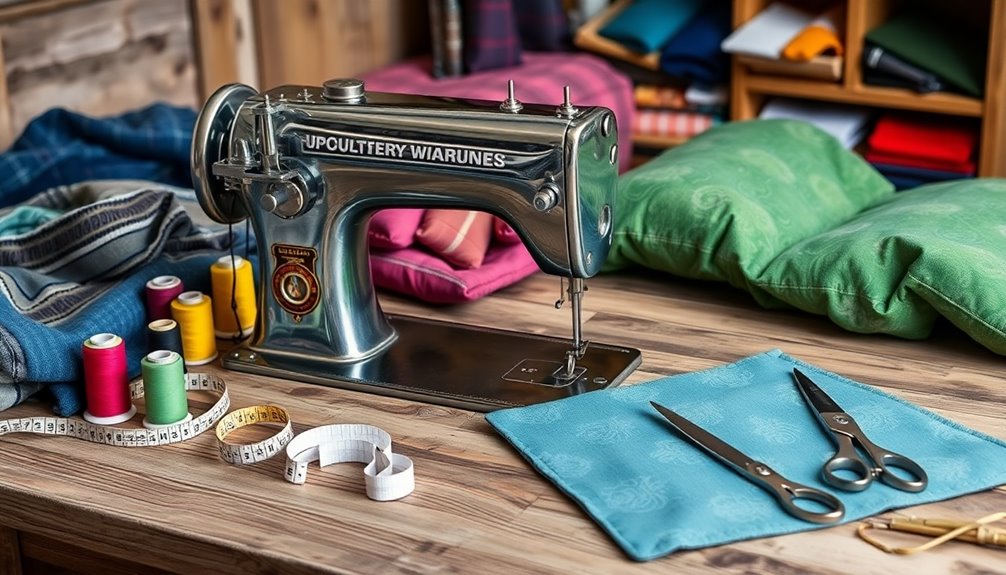
When it comes to choosing a sewing machine for upholstery work, there are several key factors I consider. I look at fabric thickness capability, motor power, and the variety of stitch options to guarantee the machine can handle my projects. Durability, build quality, and ease of use also play a big role in making the right choice.
Fabric Thickness Capability
Choosing the right sewing machine for upholstery work hinges on its ability to handle fabric thickness. I've found that not all machines are created equal when it comes to sewing through multiple layers or heavy materials like denim and canvas. Ideally, look for machines that can handle thicknesses of at least 0.2 inches (5mm) or more. This guarantees you'll tackle heavy-duty tasks without a hitch. I also recommend checking for an adjustable presser foot lift; it makes a world of difference in managing varying fabric thicknesses and maintaining stitch quality. Finally, pay attention to the feed dog design—machines with a 3-row configuration can greatly improve fabric handling, preventing slipping and guaranteeing even stitching on thick upholstery fabrics.
Motor Power and Speed
Power and speed are essential factors in selecting a sewing machine for upholstery work. A strong motor is vital since it helps the machine handle thick, heavy materials without stalling. I've found that machines with higher wattage motors generally outperform the rest. Speed ratings also matter; look for machines that offer 3,500 to 6,500 stitches per minute (SPM). This high speed can greatly cut down project time. Additionally, I recommend considering a DC servo motor for precise speed control, especially for those intricate projects. Don't forget the presser foot lift capability, which should range from 5.5 to 13mm to easily accommodate thick layers while ensuring consistent sewing performance. Choosing the right power and speed makes all the difference!
Stitch Options Variety
Having a variety of stitch options is essential for tackling different upholstery projects effectively. When I choose a sewing machine, I look for one that offers straight, zigzag, and decorative stitches. These options provide the versatility I need for various fabric types and project requirements. Specialized stitches, like reinforced or stretch, are vital for working with heavy materials such as leather or canvas, ensuring everything stays intact. I also appreciate machines with one-step buttonhole functions for that polished finish on upholstered items. Finally, having adjustable stitch length and width settings allows me to customize my approach for different fabric thicknesses and sewing techniques, making complex projects much easier to manage.
Durability and Build Quality
When it comes to upholstery work, the durability and build quality of a sewing machine are vital factors that can make or break your projects. I always recommend choosing a machine with a heavy-duty metal frame, as it guarantees stability when working with thick materials. A powerful motor is important too; it provides the piercing power needed to handle multiple layers without faltering. High sewing speeds, like 4,000 RPM or more, let you efficiently tackle extensive stitching tasks. Additionally, machines with robust builds often include automatic lubrication systems, which minimize wear and tear. Don't forget to look for an adjustable presser foot lift; it makes accommodating various upholstery thicknesses a breeze. Investing in these features will pay off in the long run.
Ease of Use
While durability and build quality are key, the ease of use of a sewing machine can greatly enhance your upholstery projects. I always look for user-friendly features like automatic needle threaders and clear threading guides to simplify setup. A straightforward stitch selection mechanism makes it easier to switch between various upholstery techniques, which I find invaluable. Plus, a top drop-in bobbin with a transparent cover lets me easily monitor thread supply, cutting down on interruptions. Adjustable presser foot heights are also essential for handling different fabric thicknesses. Finally, having a clear instructional manual and access to online tutorials boosts my confidence and efficiency, making every project smoother and more enjoyable.
Maintenance Requirements
To keep my sewing machine performing at its best for upholstery work, I prioritize maintenance requirements right from the start. Regular cleaning and oiling are essential, especially after tackling thick materials. I always use the correct lubricant, like Juki New Defrix Oil No. 1, to prevent mechanical issues and extend my machine's lifespan. I appreciate machines with mechanical designs, as they often allow me to troubleshoot minor issues independently. For those with automatic lubrication systems, I guarantee the oil flow is properly adjusted to enhance stitching quality and reduce wear. Finally, I strictly follow the manufacturer's maintenance guidelines, checking tension settings and cleaning the bobbin area to avoid thread jamming, especially when working with heavy fabrics.
Frequently Asked Questions
What Types of Materials Can I Sew With These Machines?
I often sew a variety of materials with my sewing machine. You can easily handle fabrics like cotton and linen, but I love working with denim and canvas too. For upholstery projects, don't shy away from heavy materials like leather and vinyl; they're surprisingly manageable. I've even used the machine on thicker batting and foam. Just make sure you've got the right needle and thread for each material, and you'll do great!
How Do I Maintain My Sewing Machine for Upholstery Work?
To maintain my sewing machine for upholstery work, I clean it regularly, removing lint and dust that can build up. I oil the moving parts as recommended in the manual to keep everything running smoothly. I also make sure I'm using the right needle and thread for heavy fabrics and change them out when they get dull. Finally, I store my machine in a dust-free environment to protect it when I'm not using it.
Are There Specific Needles Recommended for Upholstery Fabrics?
When I plunge into upholstery projects, I feel like an artist with a blank canvas. For those heavy fabrics, I always reach for a strong needle—specifically, a size 16 or 18 universal needle or a denim needle. These needles slice through the thick layers like butter, ensuring a smooth stitch. Trust me, using the right needle makes all the difference in creating beautiful, lasting pieces. Happy sewing!
Can I Use a Regular Sewing Machine for Upholstery Projects?
Yes, you can use a regular sewing machine for upholstery projects, but it might not be the easiest option. I've found that a heavy-duty machine works much better with thick fabrics. If you've got a standard machine, just make sure you use the right needle and thread. I've tackled smaller upholstery jobs with my regular machine, but for larger projects, investing in a more robust machine really makes a difference.
What Is the Best Thread Type for Upholstery Sewing?
When I think of upholstery projects, I picture durable fabrics, strong seams, and lasting quality. For my upholstery sewing, I've found that using polyester thread works best. It's strong, resistant to fraying, and holds up well to wear and tear. I also prefer to use a heavier weight thread for added durability. So, when tackling your next upholstery project, remember to choose polyester for the strength and reliability you need!
Conclusion
So, there you have it—15 high-quality sewing machines that can elevate your upholstery projects to new heights. But wait, before you rush off to make a purchase, think about what you really need. Are you drawn to speed, versatility, or perhaps durability? The right choice could transform your sewing experience. Imagine the satisfaction of completing your masterpiece with ease. Trust me, once you find that perfect machine, you'll wonder how you ever sewed without it!

